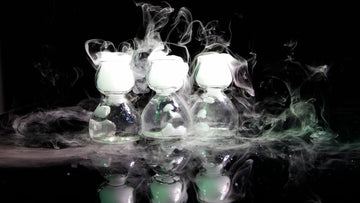Dry ice can add a magical touch to holiday parties, keep perishable foods fresh during shipping, and even come to the rescue in power outages. However, as versatile and useful as it is, dry ice must be handled with care. To help you enjoy its benefits without risks, we've put together this refresher on dry ice safety.

What is Dry Ice?
Dry ice is the solid form of carbon dioxide, and unlike regular ice, it doesn't melt into a liquid. Instead, it sublimates, turning directly into gas. This unique property makes it ideal for creating fog effects, keeping items cold, or preserving food during transit.
However, its extreme cold temperature of -109.3 F (-78.5 C) and the release of carbon dioxide gas mean you need to handle it responsibly.
Top Safety Tips for Handling Dry Ice
Use Protective Gear
- Always wear insulated gloves or use tongs to handle dry ice. Its extreme cold can cause frostbite-like burns if touched with bare skin.
Ensure Proper Ventilation
- Dry ice releases carbon dioxide gas as it sublimates. Avoid using it in enclosed spaces to prevent the buildup of gas, which can displace oxygen and lead to breathing difficulties.
Store Dry Ice Safely
- Keep dry ice in a well-insulated cooler with the lid slightly ajar to allow gas to escape. Never store it in airtight containers, as the gas buildup could cause the container to burst.
Keep Out of Reach of Children and Pets
- Dry ice can be dangerous if mishandled. Store it in a secure area and supervise its use during parties or events.
Dispose of Dry Ice Properly
- Allow unused dry ice to sublimate in a well-ventilated area. Never throw it in the trash, sink, or toilet, as it can damage surfaces or cause hazards.
Special Holiday Uses for Dry Ice
- Shipping Perishable Foods: Place dry ice on top of the items being shipped, separated by a barrier like cardboard or styrofoam. Ensure proper labeling to warn handlers of its presence.
- Creating Party Effects: Use dry ice in punch bowls or decorative displays to produce festive fog effects, but ensure no direct contact with the drink or food being consumed.
- Power Outages: Place dry ice in your freezer to keep food cold, but be cautious not to touch the ice directly or let it rest on food packaging.
Signs of Dry Ice Misuse
If you notice symptoms like dizziness, difficulty breathing, or a buildup of white fog in a poorly ventilated space, leave the area immediately and allow fresh air to circulate.
This holiday season, dry ice can be your best friend for keeping food fresh, shipping gifts, or adding some flair to your festivities. By following these safety tips, you can enjoy all its benefits without worry.
For high-quality dry ice and expert advice, contact Baker's Dry Ice in Jackson, MI. We're here to meet all your dry ice needs this holiday season and beyond. Request a quote today!




